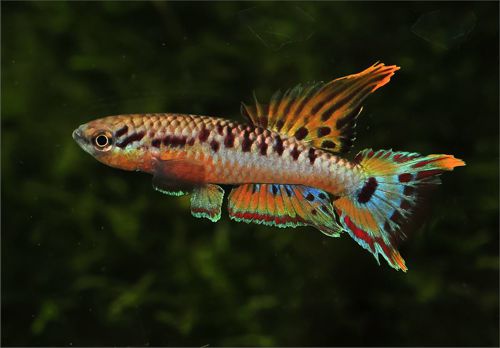Aphyosemiom bivittatum (Lönnberg 1895)

Funge (population 1)
Photo courtesy of Tony Terceira
| Meaning of Name |
Two Striped - bi = Two, vittatus = Striped. This characteristic is found more markedly on females. | |||||||||||||||||||||||
| First Description |
Löennberg 1895. Fundulus bivittatus Notes on Fishes collected in the Cameroons by Dr. Y. Sjöstedt. Öfversigt Kungl. Svenska Vetenskaps Akademiens Forhandlinger 3, Stockholm, 52, pages 190-191. Paul Arnold also wrote descriptions in Bl.Aq.Terr. 1908, p653, figures, & Woch.Aq.Terr. 1911, p601, figures. | |||||||||||||||||||||||
| Size |
5 cm. Total lengths of 9 cm have been recorded which included the long filaments to the caudal fin. | |||||||||||||||||||||||
| Meristics |
| |||||||||||||||||||||||
| Karyotype |
n = 15 - 18 A = 20 - 23 (Scheel 1990) In 1968 (ROTOW
1) Scheel reported:- | |||||||||||||||||||||||
| Sub-Genus |
Chromaphyosemion | |||||||||||||||||||||||
| Group |
A.bivittatum | |||||||||||||||||||||||
| Synonyms |
| |||||||||||||||||||||||
Populations
|
Biafra -
Fungé - First imported into the
BKA by SIC in July 1980.
Kwa River Falls Plantation - Collected by Wildekamp & Cooijmans in 1990 at Oil Palm Plantage. This is 20 kms north of Calabar.
Mundemba - This biotope
is 20 kms north of Fungé in a small stream near the waterfalls
of the N'dian River. This is the type locality where Sjöstedt
collected fish with 'longitudinal stripes'. He gave E.Lönnberg
a female from this collection which was used for the original description.
| |||||||||||||||||||||||
| Type Locality |
A rivulet near the waterfall on the Ndian River. | |||||||||||||||||||||||
| Distribution |
The low coastal plain on either side of the Nigeria
/ Cameroon border. They have been found in the lower tributaries of
the Ndian River & also in some small coastal rivers. The eastern border appears to be the population from Funge. This frontier population borders with A.volcanum. Cameroon populations are considered more colourful than those found in Nigeria. Western populations have been found with more orange in the caudal fin replacing the usual blue found in Funge. | |||||||||||||||||||||||
| Habitat |
Brooks & small streams, some being brackish. They
have been collected in well shaded pools which were rich in vegetation
& animal life. In 'A World of Killies Vol 1' by Ruud Wildekamp it
is stated that they are found in streams flowing over calcium bearing
soils. Sympatric sp. include:- A.calliurum, A.scheeli, Fp.sjoestedti, Fp.gardneri, E.grahami, E.sexfasciatus (group), Procatopus similis. | |||||||||||||||||||||||
| Distinguishing Characteristics |
Members of the sub-genus Chromaphyosemion
can be difficult to identify without first studying the individual colouration
of each species. A vertical bar in the caudal fins can often seperate this species from others in Chromaphyosemion. This can sometimes appear as 2 spots on top of each other. | |||||||||||||||||||||||
| Colour/Pattern Variability | Moderately high considering the area of distribution. | |||||||||||||||||||||||
| History |
Originally described by Lönnberg in 1895 as Fundulus bivittatus. The Type specimen (a female) was caught by Y.Sjöestedt in a small brook near Mundemba near a waterfall on the Ndian River. In 1903 Bates collected this sp. & sent 15 specimens preserved to Boulenger in London for identification. Boulenger described these as Fundulus loennbergi. First imported into Europe by the firm Siggelkow from Hamburg in 1908. Arnold most likely used these in a description in the German magazine 'Blättern' as F.loennbergi from Warri, Nigeria. Meinken used this material for his description of Aphyosemion multicolor in 1930. Also mentioned were Fundulus arnoldi & F.gularis 'Yellow'. Meinken, in 1930, had a strain from a commercial import thought to have been collected in the Calabar region of southeast Nigeria. He thought differed sufficiently enough to describe them as a new species which he did & named them Fundulopanchax bivittatus var. coerulea. The fish in circulation at this time as bivittatum were in fact bitaeniatum as we know them today. Myers found the name 'coerulea' to be already occupied & renamed them Aphyosemion bivittatum hollyi in 1933. In 1974 P.Winter collected bivittatum from the type locality. These were distributed & may be the source of the fish in captivity in more recent years being circulated as 'hollyi'. Boulenger lists these collectors/contributors in Freshwater Fishes of Africa:
This sp. has, in the past, been distributed as A.bitaeniatum & A.bivittatum hollyi. The later is invalid but A.bitaeniatum as shown by Huber in Killie Data 2000 is now a valid sp. (see A.bitaeniatum). The population from Funge was collected in 1978 by the German aquarist Armbruster. | |||||||||||||||||||||||
| Breeding Notes |
This
sp. is a typical top spawner laying eggs in floating mops & plants. Stan Langdon is someone who kept this sp (Fungé
population) from May/June 1982. Tanks are well planted with Java moss
& Ceratopteris. Stan's mix of
70% rainwater, 20% tapwater & 10% water from an established tank
was used. Water temperature 72-78°F. The fish were fed a diet of
white worm & flake. Andy Wyldes in BKA Newsletter No. 310, July 1991
put eggs on damp peat & stored at 70°F, wetting after 20 days.
All eggs hatched within 48 hours. Kadlec in BKA newsletter No.248, April 1986, observed that on hatching the fry were 5·5mm in length. At one month 2 horizontal bands will appear on the body & at 7 weeks the young will start to show sexual differences. At 11 weeks first attempts at spawning were observed. Rudolf Pohlmann on a DKG Chromaphyosemion CD, v5 - 1/2005 reported breeding them better in groups of 3 pairs in water of 200-300µs, pH 6·5, water temperature 22-24°C. He found in hard, alkaline water eggs were prone to fungus. | |||||||||||||||||||||||
| Diameter of Egg | 1.1 mm. | |||||||||||||||||||||||
| Remarks |
Although not seen these days names in the Chromaphyosemion
group have been doubled, i.e. A.bivittatum
bitaeniatum which is not correct. A.bivittatum
can only currently be called A.bivittatum
& nothing else. |